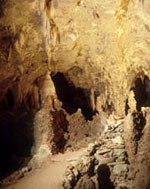On the fourth of July this year, I went underground — under the Chihuahuan Desert, that is, and into the famous Carlsbad Caverns. Carlsbad Caverns National Park in southern New Mexico has been hosting tourists for the better part of a century, so it’s got a lot of experience with showing itself off. The fabulous limestone decorations are subtly lit (a Hollywood lighting expert helped out with the placement of the bulbs), the paths are paved and protected by handrails, and large-capacity elevators whisk you up to the daylight.

Carlsbad Caverns.
Photo: NPS.
It wasn’t until a guide took a group of us into a slightly less-traveled branch of the cave, sat us down, and turned off the lights, that we got a brief look at the cave’s real self. The darkness was dense and total, and our group seemed to stop breathing. Just before the lights came back on, a little boy interrupted the silence with a loud whisper: “Mommy, I’m scared.“
Caves scare a lot of us. Even “show caves” like Carlsbad that closely control our experiences can tap into our fears of the dark, of small spaces, of being trapped. Wild caves, which by definition have no lighting and no paved thoroughfares, ask infinitely more of us. For me, just the sight of a spelunker’s map can bring on a shiver of fright and fascination. What must it be like, I wonder, to walk, crawl, and squirm through those twisting passageways for days at a time?

Entering the Stone:
On Caves and Feeling
Through the Dark
By Barbara Hurd
Houghton Mifflin,
170 pages, 2003
Writer Barbara Hurd feels these fears, too, but she’s determined to grope her way through them — and to take the rest of us along with her. The first chapter of Entering the Stone describes her terrifying introduction to caving, a belly-crawl through a tight cave entranceway near her home in western Maryland. Midway through, she was suddenly paralyzed by the feeling that “something was moving toward me, not stone, not anything I could see, maybe sound, maybe wind, and then something else: the Mack truck that barreled into my cousin’s car moments before his death.”
Hurd slowly found her way back to caving after this harrowing experience, and little by little she discovered courage, and even comfort, in the dark. She traveled from western Maryland to southern Oregon to coastal India, exploring caves with the guidance of experts and friends. In the dozen essays that make up Entering the Stone, she introduces the cave-illiterate to, among other things, a wonderful new vocabulary: The “twilight zone” of caves, she writes, has its own unique fauna, composed of both troglophiles (“cave lovers,” animals that depend on darkness and damp) and trogloxenes (the word means, roughly, “cave stranger” and refers to bears, bats, and other animals that take temporary shelter in caves). “The twilight zone is the place of exchange,” she writes, “the marketplace where things trucked in from the outside country get dribbled, shed, or excreted.”

Kartchner Caverns.
Photo: Arizona State Parks.
Hurd describes not only the caves themselves but also the dilemmas of cave conservation, best illustrated by the recently opened Kartchner Caverns State Park in southern Arizona. The discoverers of Kartchner kept the spectacularly ornate cave secret for years, but eventually decided that the best way to protect it from vandals would be to turn it into a well-regulated attraction. Now, nearly three decades after the cave was discovered, Kartchner is in many ways an archetypal “show cave.” Even though Kartchner’s visitors are managed with a near-fanatic attention to detail, the crowds inevitably leave behind cave-damaging flakes of skin and flecks of cotton lint. Maybe that’s why, in a later essay, one of Hurd’s guides dismisses all such highly decorated caves, preferring a relatively humdrum river cave. “He likes his caves less adorned, less vulnerable to human mutilation,” Hurd writes.
Though Hurd’s essays are grounded in her physical experiences with the rock, she travels far into the metaphorical. The odd subterranean substance called “moonmilk” — an oozy deposit of calcite crystals — leads her to scrutinize the human fascination with shape-shifting and the transformative effect caves have on some people. Her visit to India’s artificial Elephanta Cave, where huge basalt figures of Shiva and Parvati tower over tourists and worshippers, inspires her to ponder the power of the unknown and unsaid. She also reflects on the darkness in her own life — the death of her father, and the terminal illness of her lifelong best friend — as she ventures further underground.
Hurd meets a succession of fascinating cave researchers and recreational spelunkers during her journeys, but they aren’t plumbed quite so deeply as the caves she visits; I found myself wanting to know more about the motivations and above-ground lives of these extremely varied explorers. Perhaps Hurd’s somewhat shadowy characters are more appropriate to her subject, however. Underground, veteran cavers tell her, humans are stripped of the tags and titles that define us in the daylight, the superficial details that distinguish us from one another. The “great equalizer” of darkness, they say, is one of caving’s deepest thrills.
“Only one thing matters in there, and it’s not your job, not your looks which nobody can see anyway, not your degrees or the speed of your Internet access,” Hurd writes. “You could be inching on your behind down scrabbly slope in the mostly-dark next to the Queen of England and you’d never know it. The only thing that matters in a cave, they told me, is your ability to stay calm in dark spaces.”


